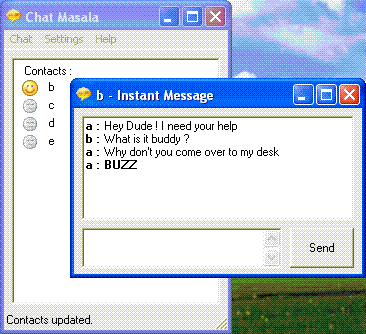
Introduction
Communication between two applications running on different (or same) systems in a Local Area Network is not a luxury, but a necessity. The .NET framework provides various solutions for solving this - Remoting, Socket Programming (TCP/UDP), Web Services etc. I will be using Remoting in my application because I believe it is the most powerful tool.
I have developed an Instant Messaging system. The system consists of a server application, a client application, and a library which is used by both the server and the client.
Without further ado, let me start explaining the code.
Using the code
Class library
The class library consists of the interface IServer and some other classes. The interface IServer dictates the functionality of the server. This information is used by the client to call the methods of the remote object.
public interface IServer
{
bool SignUp(string username,string password);
bool ChangePassword(string username,string curPassword,string newPassword);
bool SignIn(string username,string password,bool visible);
bool SignOut(string username);
bool IsVisible(string username);
bool AddContact(string username,string contact);
bool RemoveContact(string username,string contact);
ArrayList GetContacts(string username);
bool Send(string from,string to,string message);
LetterReceive Receive(string to);
ArrayList ReceiveOffline(string to);
}
LetterReceive is a class containing two string variables, from and message, and a few properties. It is very straightforward, hence I choose not to give its code.
Server
I will first explain the server class code, and once we are finished with it, I will explain the Remoting part. We will first take a look at the class hierarchy.
At the top of the pyramid, is the class Server. The Server uses the class Letter to store messages. The Server uses an object of class Database to store information which needs to persist between machine shutdowns. This includes account information and offline messages. The class Database uses the class AccountField to store information like password and contacts for a particular user. The class Database uses the class Letter to store offline messages.
We will start with the class AccountField, at the bottom of the hierarchy. Here is the code for it:
[Serializable]
class AccountField
{
internal string password;
internal bool isLoggedIn;
internal bool visible;
internal ArrayList contacts;
public AccountField(string password,bool isLoggedIn)
{
this.password=password;
this.isLoggedIn=isLoggedIn;
contacts=new ArrayList();
}
}
The class Letter has three string variables, from, to, message.
The class Database is quite simple. I will show here part of its code. The rest would be easy to guess. The Hashtable and database are used to store account information as can be seen in the method Add. It also has methods, Load and Save to load and save its instance to disk. The technique used is serialization.
[Serializable]
class Database
{
private Hashtable database;
internal ArrayList offlineMessages;
public Database()
{
database = new Hashtable();
offlineMessages=new ArrayList();
Load();
}
internal bool Add(string username,string password)
{
if(database.Contains(username))
return false;
database.Add(username,new AccountField(password,false));
return Save();
}
.
.
.
}
Let us come to the class Server. As can be seen, Server has inherited from the interfaces IServer and MarshalByRefObject (to enable Remoting). Once again, I will be show only the more important parts of the class declaration.
public class Server : MarshalByRefObject, ChatMasalaLib.IServer
{
Database database = new Database();
ArrayList letters = new ArrayList();
public Server()
{
database.Load();
}
public bool Send(string from,string to,string message)
{
if(database.ContactExists(to)==false)
return false;
if(database.IsLoggedIn(to))
letters.Add(new Letter(from,to,message));
else
{
database.offlineMessages.Add(new Letter(from,to,message));
if(database.offlineMessages.Count>maxOfflineMessages)
{
database.offlineMessages.RemoveAt(0);
}
Console.WriteLine(database.Save());
}
return true;
}
public LetterReceive Receive(string to)
{
int length = letters.Count;
for(int i =0;i < length;i++)
{
if(((Letter)letters[i]).To==to)
{
LetterReceive lr = new LetterReceive(
((Letter)letters[i]).Message,((Letter)letters[i]).From);
letters.RemoveAt(i);
return lr;
}
}
return new LetterReceive("","");
}
public bool SignUp(string username,string password)
{
return database.Add(username,password);
}
.
.
.
}
Now, we come to the Remoting part. This actually enables the communication between the server and the client.
HttpChannel channel = new HttpChannel(8080);
ChannelServices.RegisterChannel(channel);
RemotingConfiguration.RegisterWellKnownServiceType(Type.GetType("Temporary_Server.Server"),
"Server",WellKnownObjectMode.Singleton);
Client
Enough coding, let's get into action. Here is the client explained. I would first describe the Remoting initialization code.
HttpChannel channel = new HttpChannel();
ChannelServices.RegisterChannel(channel);
string hostIP = "127.0.0.1";
MarshalByRefObject obj = (MarshalByRefObject)RemotingServices.Connect(
typeof(IServer),"http://"+hostIP+":8080/Server");
server=obj as IServer;
(obj as RemotingClientProxy).Timeout=5000;
The tough part is over, now we only have to call the methods of the variable server to work. Here, I have given a few examples:
server.SignIn("AmitDey","Password",true);
server.IsVisible("Boss");
server.Send("AmitDey","Boss","Work complete. Can I go home ?");
server.Receive("AmitDey");
The client code is huge, distributed into many forms. But, it's all so easy that I am not sharing it with you here. You can check it out in the source code files available at the top of this page.
Points of interest
If you are running the demo project, for your own ease, start the server application first and then the client application.
Here is a pretty ugly problem I faced. Consider the situation where the server is not loaded, but the client application is started. If the client application tries to access any method of the server variable, the client application simply hangs. It does not even cause an exception. In order to simulate a time out, I used this code. I would like to thank my friend Kuldip Saini for this solution.
(server as RemotingClientProxy).Timeout=5000;
I would also like to thank Bipin George Mathew and Kin Tutnik for helping me develop this application.
